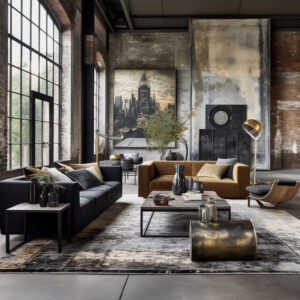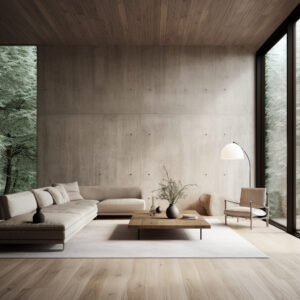Design Tips for Creating a Scandinavian-Style Interior
Introduction
Nordic winds bring more than just the chill of the north; they carry the essence of simplicity and tranquility in the form of Scandinavian Style—an interior design trend that has transcended geographical boundaries to create comfortable, functional, and aesthetically pleasing living spaces. Embraced for its minimalistic yet cozy approach, Scandinavian interior design is a testament to the harmony of form and function, a tranquil palette, and an attentiveness to crafted detail that transforms houses into inviting homes.
Key Elements
In the realm of interior design, there are certain principles and elements that define a space’s character. When cultivating a Scandinavian Style atmosphere, several key elements stand out:
- Element 1: Color Palette
Serene and earthy, the color palette used in Scandinavian Style often revolves around soft, muted hues — think shades of gray, blue, and cream that replicate the calming effect of a snow-clad landscape. - Element 2: Furniture Arrangement
Scandinavian furniture is renowned for its clean lines and functional design. The arrangement prioritizes movement and negative space, fostering a sense of balance and simplicity. - Element 3: Lighting
Given the limited daylight hours in Nordic countries, lighting is a pivotal aspect of Scandinavian interior design. It’s all about creating a warm, inviting glow with multiple light sources. - Element 4: Natural Materials
Incorporating natural materials such as wood, wool, and leather adds texture and warmth to the composition, reinforcing the connection to nature that is at the heart of this style. - Element 5: Accessories
Thoughtful accessorizing is vital — a handpicked selection of ceramics, plush textiles, and botanical elements deliver personality and life to the functional aesthetic.
Tips for Scandinavian Style
When selecting furniture and designing your space in the Scandinavian Style, keep these considerations in mind:
- Emphasize Functional Minimalism
- Look for pieces that serve a purpose without sacrificing style. The 'less is more’ ethos should guide your purchases, and every item must earn its place in your room.
- Prioritize Quality Over Quantity
- Scandinavian design advocates for lasting quality. Opt for well-crafted items made of sustainable materials that won’t demand frequent replacement.
- Choose Understated Elegance
- Furniture should exhibit grace with clean silhouettes and understated elegance. Ornamentation is minimal but thoughtfully executed.
- Invest in Iconic Pieces
- Classic pieces such as the Eames chair can serve as focal points that encapsulate the timeless appeal of Scandinavian design.
- Mix Textures for Comfort
- When it comes to textiles, layer different textures. Wool, sheepskins, and soft cotton can provide warmth and depth, amplifying a sense of cozy sophistication.
FAQ about Scandinavian Style
Question 1: How do I add a pop of color to a Scandinavian Style interior?
– Answer: Stick to soft pastels or rich earth tones that complement the neutral palette but offer a subdued contrast. Accent items, such as cushions, throws, or artwork, are ideal for introducing color without overwhelming the space.
Question 2: What kind of wood finishes are typically used in Scandinavian furniture?
– Answer: Light woods such as pine, birch, and oak are predominant. These finishes maintain the airy ambiance and work in harmony with the muted color scheme typical of Scandinavian interiors.
Question 3: How can I achieve a Scandinavian look on a budget?
– Answer: Focus on simplicity and opt for minimalist designs that are functional yet stylish. Thrift shops and second-hand stores can be treasure troves for Scandinavian-style finds. DIY projects, such as painting old furniture or creating handmade decor, can also add personal flair without a hefty price tag.
Question 4: Are patterns and prints acceptable in Scandinavian Style interiors?
– Answer: Yes, but moderation is key. Geometric prints and stripes are popular choices that align with the minimalist and modern aesthetic. They should be used sparingly to maintain the serene ambiance.
Question 5: How do I balance modern appliances with Scandinavian Style?
– Answer: Opt for sleek and simple designs in appliances, preferably in muted colors that can seamlessly blend into the space. Integrating smart storage solutions can also minimize visual clutter, keeping the focus on the design’s clean lines.
The resurgence of Scandinavian Style in the interior design landscape is a nod to timeless simplicity and a natural elegance that feels both progressive and comforting. As we usher in the minimalist charm and warmth of Nordic design into our homes, it is evident that this style transcends mere trends, offering a sustainable and harmonious vision for modern living spaces. Whether you are a seasoned enthusiast or newly enamored with the serene allure of Scandinavian design, embracing these principles can transform your dwelling into a sanctuary of peaceful beauty.
For those seeking to delve deeper into the world of interior design, staying current with emerging styles and integrating elements of Scandinavian Style can provide a fresh, modern perspective while maintaining a cozy, lived-in feel. After all, a well-designed home is not just about aesthetics—it’s about creating an environment that resonates with the soul, and Scandinavian Style does just that.




